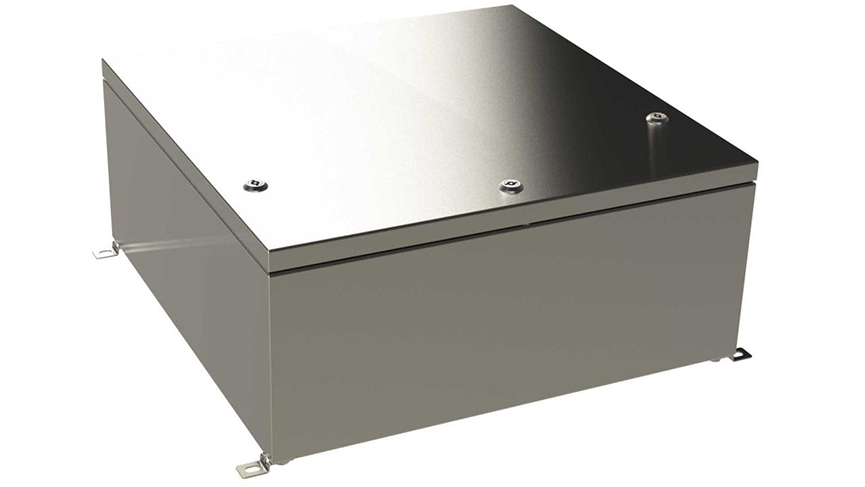Industrial environments are tough on equipment. From corrosive chemicals and extreme temperatures to dust and moisture, sensitive electrical and electronic components face constant threats. Protecting these vital assets is crucial for maintaining operational continuity and safety. A high-quality stainless steel enclosure provides the robust defense needed to shield equipment from harsh conditions, ensuring reliability and longevity.
This article will explore the importance of industrial stainless steel enclosures. We will cover their key benefits, the different types available, and their wide-ranging applications. Finally, we will provide practical tips to help you select the right enclosure for your specific needs.
Why Stainless Steel Enclosures are Essential
In any industrial setting, from a food processing plant to an offshore oil rig, equipment is an investment. The controls, circuits, and systems that automate and manage processes are the nerve center of the operation. Failure of these components can lead to costly downtime, production losses, and significant safety hazards. Industrial enclosures serve as the first line of defense, protecting this critical equipment from environmental damage.
Stainless steel is a superior material for this purpose due to its unique combination of properties. Unlike plastic or standard carbon steel, stainless steel offers exceptional resistance to corrosion, rust, and chemical damage. This durability makes it an ideal choice for industries where cleanliness is paramount or where exposure to harsh substances is common.
Key Benefits of Stainless Steel Enclosures
Choosing stainless steel for your industrial enclosures offers several distinct advantages that contribute to long-term value and performance.
Superior Corrosion Resistance
The primary benefit of stainless steel is its remarkable ability to resist corrosion. The chromium content in the alloy forms a passive, self-repairing layer on the surface that protects it from rust and degradation. This is particularly important in marine, chemical, and wastewater treatment environments where salt, moisture, and corrosive agents are constantly present.
Durability and Strength
Stainless steel enclosures are incredibly strong and impact-resistant. They can withstand physical abuse, vibrations, and extreme temperatures without warping or breaking. This physical toughness ensures that the sensitive equipment inside remains protected even in the most demanding physical environments, such as manufacturing floors or outdoor installations.
Hygienic and Easy to Clean
The non-porous surface of stainless steel makes it easy to clean and sanitize, which is a critical requirement in the food and beverage, pharmaceutical, and medical industries. The material does not harbor bacteria or other contaminants, helping organizations comply with strict health and safety regulations. Its smooth surface withstands frequent washdowns with high-pressure water and harsh cleaning chemicals without degrading.
Aesthetically Pleasing and Professional Appearance
Beyond its functional benefits, stainless steel has a clean, modern, and professional look. A well-crafted enclosure can enhance the appearance of an installation, reflecting a commitment to quality and durability. This aesthetic appeal is often a welcome bonus in facilities where appearances matter.
Common Types of Stainless Steel Enclosures
Stainless steel enclosures are available in various types, each designed for specific environments and protection levels. The two most common grades of stainless steel used are Type 304 and Type 316.
Type 304 Stainless Steel
Type 304 is the most widely used grade of stainless steel. It offers excellent corrosion resistance in most indoor and outdoor environments. It is a cost-effective solution for general-purpose applications where exposure to severe corrosive agents, like salt or industrial chemicals, is not a primary concern. It is often found in food processing and dairy facilities.
Type 316 Stainless Steel
For more demanding conditions, Type 316 stainless steel is the preferred choice. It contains molybdenum, an element that significantly enhances its resistance to chlorides, salts, and acids. This makes Type 316 enclosures ideal for marine environments, wastewater treatment plants, chemical processing facilities, and any application with high salinity or exposure to corrosive chemicals.
Applications Across Industries
The versatility of stainless steel enclosures makes them suitable for a vast array of industrial applications.
- Food and Beverage: Protecting control panels for processing and packaging machinery while meeting strict hygiene standards.
- Pharmaceutical and Biotech: Housing sensitive electronics in cleanroom environments that require frequent sterilization.
- Oil and Gas: Shielding electrical systems from corrosive elements on offshore platforms and at refineries.
- Water and Wastewater Treatment: Protecting motor controls and monitoring equipment from moisture and chemicals.
- Manufacturing: Securing automation controls, PLCs, and VFDs from dust, debris, and physical impact on the factory floor.
- Telecommunications: Housing communication equipment in outdoor cabinets exposed to varying weather conditions.
How to Select the Right Enclosure
Choosing the correct stainless steel enclosure is vital for ensuring optimal protection. Consider the following factors to make an informed decision:
- Assess the Environment: Determine the specific hazards in your environment. Will the enclosure be exposed to water, dust, chemicals, or extreme temperatures? Answering this question will help you determine the necessary NEMA or IP rating, which indicates the level of protection against solids and liquids.
- Choose the Right Material: Decide between Type 304 and Type 316 stainless steel. If your application involves saltwater, de-icing salts, or aggressive chemicals, invest in Type 316 for its superior corrosion resistance. For less harsh environments, Type 304 is often sufficient.
- Consider Size and Configuration: Ensure the enclosure is large enough to house all components comfortably while allowing for proper heat dissipation and future expansion. Think about door configurations, mounting options (wall-mount, floor-mount, or freestanding), and entry points for cables.
- Factor in Thermal Management: Electronic components generate heat. An improperly ventilated enclosure can lead to overheating and equipment failure. Evaluate whether you need vents, fans, or an air conditioning unit to maintain a stable internal temperature.
By carefully evaluating these factors, you can select an industrial stainless steel enclosure that provides reliable, long-lasting protection for your critical equipment, safeguarding your operations for years to come.



